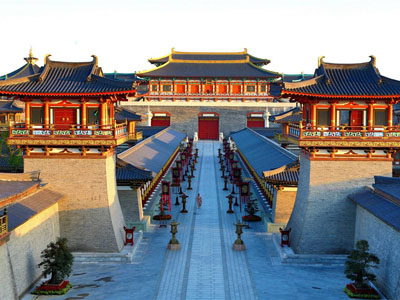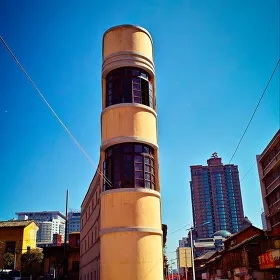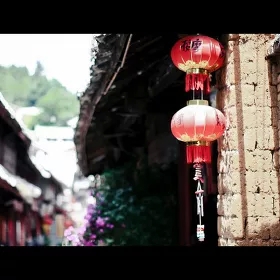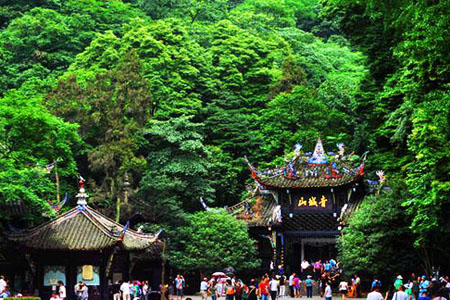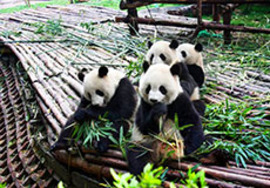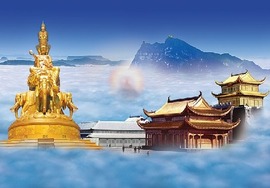The economic importance of this city derives from its geographical position. This special position also makes it an important trade center in this region of the nation. Meanwhile,It's also the houses of some manufacturing, chiefly copper,some other chemicals, though chiefly copper, machinery, textiles, paper and cement take key. Its modern prosperity dates only from 1910, when the railway from Hanoi was built. The city has continued to develop rapidly under China's modernization efforts. Kunming's streets have widened while office buildings and housing projects develop at a fast pace. Kunming has been designated a special tourism center and as such sports a proliferation of high-rises and luxury hotels.
Attractions of Kunming:
Kunming Stone Forest
Kunming Shilin Stone Forest Scenic Spot, also known as Yunnan Shilin, is 78 kilometers away from Kunming, the capital of Yunnan Province. The range is about 350 square kilometers. Kunming Shilin Stone Forest Scenic Spot has been rated as "World Geopark" and "World Natural Heritage scenery" by the United Nations Culture, Education and Science. In 1982, it was approved by The State Council to become one of the first national key scenic spots. It is a national 5A level tourist attraction and a national civilized scenic tourist area. The climate belongs to the subtropical low latitude plateau mountain monsoon climate, the annual average temperature is about 16℃, with no severe cold in winter, summer without heat, the four seasons like spring.
Kunming city stone forest scenic area developed as a tourist area is mainly: stone forest scenic area, black pine rock (is the ancient stone forest) scenic area, flying dragon waterfall (big stack water) scenic area, long lake scenic area.
Small stone forest
Small stone forest, also known as Ashima scenic area, the thick and thick pier solid stone wall like a screen, the small stone forest is divided into a number of gardens. The most famous scenic spot in the small stone forest is "Ashima". When the night falls and the colorful lights shine, it is colorful and charming.
Big stone forest
The large stone forest is composed of dense stone peaks, just like a stone basin. The stone forest stands erect, smooth, and has a faint greenish gray, and the largest independent column is more than 40 meters high. Among them, there are "lotus peak", "Jianfeng pool", "a" critical moment "," the "extremely narrow people", "elephant", "deep orchid deep valley", "phoenix" comb wings and other typical scenic spots, the most famous is the "Stone Forest" of Longyun inscription "Stone Forest", and "Wangfeng Pavilion" is the best place to appreciate "Linhai".
Yi Ethinic People Torch Festival
The Torch Festival is held on the 24th day of the sixth lunar month. It is a traditional festival for the Yi people to destroy the evil and celebrate the harvest. On the day of the festival, the men, women and children, dressed in festive costumes, will celebrate the annual traditional festival in the depths of the stone Forest, the shore and the foot of the mountain.
Ashima Culture
The Yi and Sani people who have lived in the Shilin area for generations have formed the national culture represented by "Ashima culture". Ashima story uses oral poetry language to tell or sing the story of Ashima,a beautiful girl. The legend of Ashima against the powerful of landlored, reveals that the light will replace the dark, beauty will be instead of ugly, freedom will replace oppression. It reflects the Yi people "bent" national character and national spirit. The narrative long poem "Ashima" selected the first national intangible cultural heritage, was translated into more than 20 languages in many countries in the world; the film "Ashima" renowned at home and abroad.
Kunming Dian Lake
Dianchi,or Dianchi Lake is also called Kunming Lake, Kunming Pool. The largest freshwater lake in Yunnan Province, China, known as the pearl of the plateau, is in the southwest of Kunming city. Panlong River and other rivers injection. The lake surface is 1886 meters above sea level, an area of 330km², the average water depth of 5 meters, the deepest of 8 meters. The lake flows out in the southwest estuary, which is called the upper source of the Purdu River, a tributary of the Jinsha River.
Dianchi Lake is called "Dianchi Lake" because it is surrounded by "Dian" tribes or "Dian people". Dianchi Lake is an earthquake fault subsidence lake, which looks like a crescent moon. The elevation of the lake is 1886 meters above sea level, with 39 kilometers long from north to south, and the widest distance is 13 kilometers from east to west. The lake shoreline is 163.2 kilometers long, with an area of 306.3 square kilometers, and has a water capacity of 1.57 billion cubic meters. It is widely known as "500 Miles Dianchi Lake". The main rivers are Panlong River, Jinzhu River, Baoxiang River, Haiyuan River, Malaysia River, Luolong River, Laoyu River, etc., and the water outlet is Mantis River. Dianchi Lake water flows into the pudu River from the estuary. Into the Jinsha River. It is the Yangtze River system with a basin area of 2855 kilometers. It is the sixth largest freshwater lake in China and a bright plateau pearl. There is Jinma Mountain in the east, Biji Mountain in the west, Snake Mountain in the north and Heshan in the south. These mountains are undulating, forming a natural barrier of Kunming Bazi. The fertile lakeside land, mild climate and abundant water are conducive for irrigation and navigation. The average temperature is 14.5-17.8 degrees, and the rainfall is 1070 mm. Kunming Bazi is rich in rice, wheat, broad beans, corn, oil and other crops, and is a famous "hometown of fish and rice" in Yunnan.
Kunming Cuihu Park
Cuihu Lake Park is located at the west foot of Wuhua Mountain in Kunming city, which is the central sightseeing point of the city. Because of its eight sides of water, four seasons of bamboo, spring and summer willow, it is called "green Lake". Cuihu Lake is known as the "emerald" inlaid in Kunming city.
Before the Yuan Dynasty, the water level of Dianchi Lake was high, and it also belonged to the small lake bay outside the city, with many rice fields, vegetable gardens and lotus ponds, therefore called "Vegetable Sea".
Because there are nine springs in the northeast, confluence into a pool, also known as "Nine Dragon Pool". To the early years of the Republic of China, changed to a garden, the garden planted willows, a variety of lotus in the lake, the "green Lake" reputation.
The north and south transverse dike was called "Ruan dike", which was built in the form of Ruan Yuan, governor of Yunnan, during the reign of Daoguang in Qing Dynasty . The east and west longitudinal dike was called "Tang dike", which was built during the Republic of China. The junction of the two dikes is a small island in the middle of the lake, with the pavilion of the lake as the main axis, forming the central swimming area. The pavilion in the middle of the lake is also called "Biyi Pavilion", with flying eaves and yellow tiles. There are two inner courtyards inside the pavilion, which are held for various exhibitions.
The Cuihu Lake is also a good place for bird-watching. The snow-white red-headed gulls, from November to March of the following year, flew here from the far north for the winter, every year, without interruption."Cuihu view of gulls" has become one of the popular landscapes in Kunming.
Xishan Hill and Longmen Gate
The Western Mountain is located 15 kilometers in the western suburb of Kunming city, Yunnan Province, and is composed of Huating Mountain, Taihua Mountain and Luohan Mountain. It has peaks of more than 40 kilometers of 1900 meters to 2350 meters above sea level. Legend has it that in ancient times, there is a phoenix stop, local people do not know it, and called it for green chicken, so also Xishan Hill is also called Green Chicken Mountain. And because of the shape like the sleeping Buddha, also called the Buddha mountain. Xishan hill has dense forest, flourishing flowers and plants, quiet and beautiful, excellent scenery. It has "the first best environment in Yunnan" reputation in ancient times. From the distance of Kunming, the Western Mountain is like a beautiful woman lying on both sides of the Dianchi Lake. Her face, chest, abdomen, legs and even the hair drooping into the water are clear and clear, and appear beautiful and charming, so it is also called "Sleeping Beauty".
Longmen, Dragon Gate, is located on the Xishan mountain, which is the most amazing part of the whole Western mountain, and enjoys a great reputation both at home and abroad. Local characteristics: exquisite stone carving is the biggest feature of the Longmen, the Longmen stone carving is carved along the cliff wall, all the projects are manually completed by a hammer and a chisel. The carving structure of the Longmen room is beautiful, and the carving is fine. Kuixing, Wenchang and Guan Sheng are carved into rocks, exquisite and lifelike. Sanqing Pavilion is built between the cliffs and cliffs, just like a pavilion in the air, from afar, the floors stacked yu, flying to fly, the scenery is quite spectacular. Sanqing Pavilion is the location of Taoism. The surrounding plaques or couplets not only render the religious color of the Taoist temple, but also provide realistic scenery, incorporating life philosophy in one furnace. In this view scenery, can wash the earthly troubles, let a person mind comfortable, refreshed.
the Longmen Grottoes
Longmen Grottoes is located at the end of Xishan Scenic Area, starting from Sanqing Pavilion in the north and reaching atian Pavilion in the south. It is the largest and most exquisite Taoist grottoes in Yunnan."Longmen Scenic Spot" is characterized by "strange, unique, dangerous and secluded". It is the first of many scenic spots in the western mountains of Kunming and enjoys a high reputation at home and abroad. Tourists to Kunming must-visit. At the entrance, there is a cylindrical stone square, on the word "Dragon Gate", and engraved with "ingot", it is said to bless people to make a fortune, good luck, so visitors like to touch with their hands. There is a stone fence to protect the center of a small semicircular platform, standing on the platform overlooking, people see the wind, under the cliff, 500 miles of Dianchi Lake vast, steaming clouds. The lake is dotted with white sails, and the gulls are flying. Green mountains in the distance such as belt, white clouds leisurely, green trees white room, plain fertile wild picturesque, breathtaking. Turn to review the stone room, the top of the main door is engraved with words of "sky Pavilion" , both sides of the side of the door is engraved with "mountain", "stone room", "sky sea mirror", the column has the cloud: difficult, to stand firm; in Xiaohan, more appropriate mood flat.
Dongchuan Red Land Scenic Area
Dongchuan Red land refers to the Xintian Township, more than 40 kilometers southwest of Dongchuan District of Kunming City, with a place called "Flower Stone" (at the 109 public milestone). The area of nearly 100 miles here is the most concentrated, typical and distinctive red land on the red soil plateau of Yunnan. The Dongchuan red land is located in a warm and humid environment, and the iron in the soil is slowly deposited through oxidation, gradually forming a dazzling color. Dongchuan Red Land Scenic Area is considered by experts to be the most imposing red land in the world outside Rio de Janeiro, Brazil, and its scene is more magnificent than the red land of Brazil.
Every year from September to December, part of the red earth to be planted, another part of the red earth has been planted green barley or wheat and other crops, from a distance, like the color blocks of the sky, gorgeous, lined with the blue sky, white clouds and the unpredictable light, constitute the spectacular scenery of the red earth.
Jiuxiang Scenic Area
Jiuxiang Scenic Spot is located in Jiuxiang Yi and Hui Township, Yiliang County, 90 kilometers away from Kunming and 47 kilometers away from Yiliang County. Located in the mountainous area, the climate is cool, the area peaks continuous, the valley of the relative height difference of about 200 meters, the surface elevation in 1750~1900.
The scenic area is mainly cave landscape, famous for the six wonders. There are layers of terraced fields, two waterfalls with a drop of more than 30 meters, three natural stone Bridges with a height of more than 200 meters, four hall cave lion halls, five Jingsoul Gorges with a height of more than 80 meters, and six Yincui Gorge of "the first gorge in central Yunnan". Rainbow Bridge, Dali Dam, Shaba, Sanjiao Cave, Alulong, Mingyue Lake and other scenic spots have been planned and built.
Jiuxiang has coverage rate of 62.3% in dense forest, and rich precious animal and plant resources. The ancient human habitation site, which represents a unique Paleolithic culture in southern China, is known as "nine townships and one unique". Jiuxiang Scenic spot is a member of international Cave Association and a national key scenic spot. It is a new comprehensive scenic area with karst cave landscape as the main body and integrating natural scenery, cultural landscape and ethnic landscape.
Guandu Old Town
Kunming Guandu Old Town, located in the southeast suburb of Kunming, is one of the famous historical and cultural towns. It is one of the birthplaces of Yunnan culture, and it is the main historical and cultural landscape of Yunnan tourism, especially Kunming tourism. Guandu ancient town has a long history in the Nanzhao period of Dali State. It has been a big market town and traffic artery on the northeast bank of Dianchi Lake. Before the Song Dynasty, ferries were set up, fishing boats and passing official ships stopped here and sat again Sedan or riding over the Zhuangyuan building into Kunming city, hence the name "Guandu". There are many ancient buildings, Buddhist temples, attics and temples in the ancient towns, commonly known as "six temples, seven pavilions and eight temples". There are more than 10 national, provincial, municipal and district level cultural relics protection units: the Tujia Temple built in the Tang Dynasty, the statutory Temple in the Song Dynasty, the East Pagoda of Miaozhan Temple in the Yuan Dynasty, the Confucius Building and the Diamond Tower in the Ming Dynasty, among which the Diamond Tower is listed as a national cultural relics protection unit. In history, Guandu was an important ferry for ships in Dianchi Lake, and also a market town with relatively developed politics, economy and culture on the main traffic road leading to southern Yunnan. It was known as "Little Yunnan" in the Ming and Qing Dynasties.
To Guandu ancient town, in addition to see a variety of cultural landscape, food is not to be missed. Here the snacks gather together, it is a lucky place for foodies. Holiday and more people, Zhuangyuan street several stores will be a long line. Guandu rice noodles, Guandu Baba and Guandu bait blocks are known as the "three treasures". You must taste them.
Dounan Flower Market
Dounan Flower Market is the largest flower market in Asia, adjacent to the east bank of Dianchi Lake in Chenggong District, Kunming City, and enjoys the title of "Golden Dounan". Kunming Dounan Flower Market, has now developed into the largest fresh cut flower trading market in Asia, is a famous flower capital.
Market existing cut flowers trading hall, rose hall, car hall, boutique flower market. More than 10000 visitors coming here daily, and it has listed flowers 66 categories, more than 300 varieties,. Market have trade about 400-6 million and provide income of 350-5.50 million yuan. Every day more than 280 tons of fresh cut flowers by air, railway, highway to the country more than 60 large and medium-sized cities, some even exports to Japan, South Korea and other 46 countries and regions in the world.
Main wholesale sales of commodities: carnations, Chinese rose, Oriental lily, forget-me-not, star in the sky, lover grass, gerbera, Platycodon grandiflorum, chrysanthemum, violet, bird of paradise, snapgrass, stone bamboo plum.
Kunming Golden Horse and Green Chicken Gate
Kunming Golden Horse and Green Chicken Gate is located in the downtown area of Kunming, Yunnan Province. It is two memorial archways. East Gate is called Gorlden Horse Square, and West Gate is called Green Chicken Square, which is 12 meters high, 18 meters wide and separated by tens of meters. The delicacy of Golden Horse Bi Chicken Square lies in the wonder of "Jinbi intersection". When the sun does not set, the afterglow from the west, its reflection into the east street, the moon just rises in the east, the silver light on the golden horse lane, the reflection. This is the spectacle of the "gold glow" that only happens once in 60 years. According to legend, during the Daoguang years of the Qing Dynasty, this spectacle once appeared once. It is said that due to the Angle of the earth, the moon and the sun, such a spectacle takes 60 years to appear once. The design of "Golden Horse Bi Chicken Square" reflects the extraordinary attainments of ancient Yunnan people in mathematics, astronomy and architecture.
World Horticultural Exposition Garden
Kunming World Horticultural Exposition Park (hereinafter referred to as the Expo Park) is the site of the 1999 Kunming International Horticultural Exposition, located in the northeast suburb of the Golden Temple of Kunming, about 4 kilometers away from the Kunming city. The expo park covers an area of about 218 hectares, with vegetation coverage of 76.7%, among which 120 hectares of gentle slope with dense shrubs, and the water surface accounts for 10%~15%. Park overall planning on the mountain, set the national provinces, autonomous regions and municipalities local characteristics and 95 countries style garden gardening, courtyard architecture and scientific and technological achievements in a garden, embodies the "man and nature, harmonious development" era theme, is a "Yunnan characteristic, Chinese style, world-class" garden gardening grand view garden.
Yunnan Ethnic Village
Yunnan Ethnic Village is located on the bank of Dianchi Lake in the southwest suburb of Kunming city, Yunnan Province, covering an area of 89 hectares. It is a window to reflect and display the social and cultural customs of 26 ethnic groups in Yunnan province. Ethnic village is a national AAAA level tourist attraction and an ethnic culture base of the State Ethnic Affairs Commission. The scenic spot shows the ethnic customs of Yunnan through dozens of Dai villages, Buyi villages and other ethnic customs.
Since its establishment and opening in February 1992, Yunnan Ethnic Village has displayed the architectural art, songs, dances and costumes, cultural customs, religious beliefs and living customs of various ethnic groups in Yunnan in a vivid form. There are more than 10 national folk intangible cultural heritage festivals, such as Torch Festival, Water-sprinkling Festival and Munao Song Festival; more than 30 national, provincial, folk music, dance and more than 10 national, provincial and municipal intangible cultural heritage of traditional handicrafts, such as Jianchuan wood carving and Yi embroidery skills.
Yuantong Temple,
Yuantong Temple is located in Yuantong Street in Kunming city. It is one of the oldest Buddhist temples in Kunming and one of the earliest Avalokitesvara temples in China. It has a history of more than 1,200 years. Because of its long history, magnificent buildings, and convenient transportation, it is now the largest place for Buddhist activities in Kunming City.
Yuantong Temple was initially built in the Nanzhao Period of the Tang Dynasty and was first named Butuo uo Temple. In the fifth year of Dade (1301 AD) in Yuan Dynasty, it was renamed Yuantong Temple, and the emperor of the Yuan Dynasty "gave the seal and praise in book ". It was rebuilt many times in the Qing Dynasty. Yuantong Temple scenery is quiet and strange, solemn temple, spectacular pavilions, jagged rocks, waterside pavilion winding paths. All kinds of stone steps, stone paths, stone Bridges, stone bars and so on are well arranged and have its unique style. The Yuantong Temple is not only a famous Buddhist temple, but also a secluded and scenic tourist area. In the Ming and Qing dynasties, the Yuantong Temple was constantly repaired, and most of the existing temple buildings were built in the Qing Dynasty.
